Tour Stop
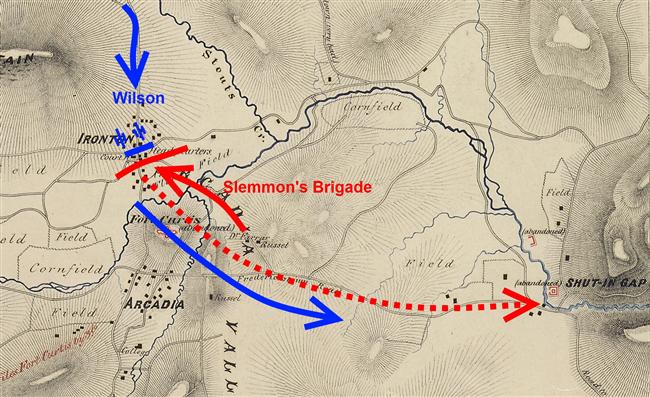
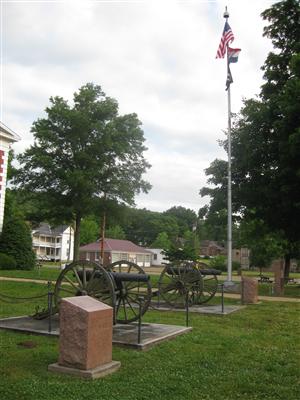 Directions: There are two historical markers next to one another at the Iron County Courthouse. The Iron County Courthouse [ Waypoint = N37 35.867 W90 37.685 ] is located at 250 South Main Street, Ironton, MO 63650.
Directions: There are two historical markers next to one another at the Iron County Courthouse. The Iron County Courthouse [ Waypoint = N37 35.867 W90 37.685 ] is located at 250 South Main Street, Ironton, MO 63650.
- From the Grant Monument return to Main Street and turn left (north).
- The courthouse square is about two blocks ahead at the northwest corner of Main and Russell Streets.
- Find a place to park and you will find two historical markers near the 3-inch Ordnance Rifles in front of the courthouse.
Historical Marker: Battle of Pilot Knob (Montgomery's Battery)
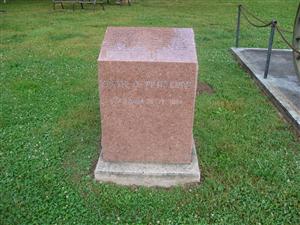
The historical marker on the left (south) [ Waypoint = N37 35.865 W90 37.666 ] marks the location where a section of Montgomery's Battery engaged the Confederates on The text on the historical marker:
Battle of Pilot Knob
September 26-27, 1864
A section of Montgomery's Battery, two 3-inch Ordnance Rifles, under Lt. Simonton, helped drive the rebels back into Shut-In Gap and held them there until fighting ceased at sunset on the 26th. Early the next morning, Simonton's guns, positioned in front of the courthouse, fired at the attacking rebels. Rebel cannon responded by firing into Ironton and hitting the court house. The two guns that you see here are identical to Simonton's.
One section (two guns) of Battery H was used as mobile field artillery during the Confederate advance up the Arcadia Valley while the other four guns were brought inside of Fort Davidson and set up as fixed artillery. Lieutenant Morgan Simonton remained in command of the mobile section throughout the fighting. Capt. William C. F. Montgomery, Battery H, Second Missouri Light Artillery. [54]
"On September 26, the rebels were discovered in small force advancing on Arcadia, two miles southwest of Ironton … Major Wilson was ordered with the cavalry and one section of my battery, Lieutenant Simonton in command. The section remained in the front till 10 p.m., when it returned to the fort with the other two sections. We immediately set to work constructing platforms for the remaining four guns. Tuesday, September 27, at 3 a.m., Lieutenant Simonton was again ordered to the front with his section."
Lieutenant T. M. Montgomery, Battery H, Second Missouri Light Artillery, wrote about what Brigadier-General Thomas Ewing, Jr. ordered done with Battery H. [55]
"About sundown, Lieutenant Simonton was sent with the first section of Battery H and with other forces to Ironton, where they remained until about midnight when they fell back to a position near the fort. When Simonton's section went to Ironton the other four guns were ordered inside the fort, and the men set to work throwing up earth embankments for the guns, so that they might fire over the parapet."
Historical Marker: Iron County Courthouse
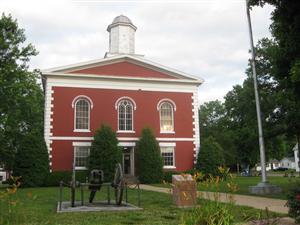
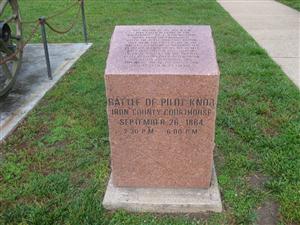
The historical marker on the right (north) [ Waypoint = N37 35.871 W90 37.666 ] describes fighting that took place here on September 26, 1864. The text on the historical marker:
Battle of Pilot Knob
Iron County Courthouse
September 26, 1864
2:30 P.M. – 6:00 P.M.
Pvt. Rector of the 3rd M.S.M. was killed in front of the courthouse. Co. E., 47th Missouri, firing from the courthouse, killed the rebel who shot Rector. They were the first to die in the battle. A cavalry detachment led by Major Wilson drove the rebels back to Shut-In Gap. Fighting ended at sunset. On the 2nd day rebel artillery fired into Ironton and hit the courthouse. The imprint of one of the shells can still be seen in its facade.
Lieutenant W. C. Shattuck, Company I, Third Missouri State Militia Cavalry Regiment led a skirmish line against the Confederates. He described what happened after Major Wilson arrived with reinforcements. [56]
"Wilson … placed himself at our head, and we drove the enemy before us to Arcadia. Then we fell back to Ironton and formed line near the courthouse … the Confederates had torn down the rail fence around a field of about sixty acres in extent, lying along the front of our line. In every one of the fence corners was one of the enemy's riflemen. Two companies of the Fourteenth Iowa Infantry, under Captains Campbell and Lucas and a four-gun battery,—H, of the 2nd Missouri Light Artillery,—had reached us by this time and were deployed upon the right of the line. This was the situation when I was ordered by Major Wilson to take command of one hundred skirmishers and advance in front of the line."
"It was about three o'clock p. m. There was no cover in the whole extent of the field in front except a row of fence posts about five feet high and from ten to fifty feet apart. One-half of the skirmishers advanced, fired, and then dropped upon the ground to reload. Then the other half did the same, all being dismounted, while I rode up and down in the rear of the skirmish-line directing the advance. The sun was shining brightly, every button, scabbard, and shoulder-strap was glistening. The whole command in their places in the rear were closely watching the movements of the advancing skirmishers. I was the only mounted man in the field. I had been in the forlorn hopes of rearguards and in the desperate charge of the advance; but all these were as nothing as compared with the advance across that field. The fact that I knew that every triangle of fence-rails sheltered a finished marksman, who had a dead rest for his gun, did not help me. Men were dropping from the line, the air around me seemed thick with balls; my horse was restive; it appeared that I was the only object to shoot at in all that bright expanse. Still the line advanced until we reached the timbered border of the field and drove out the enemy. The skirmishers received their horses from their holders and joined in the charge from that point to the 'Shut-in,' on the road to Fredericktown. Here the enemy had their dismounted men posted upon the timbered hillside along the road. Their fire was terrific. Wilson was wounded in the front part of the head and knocked from his horse. He jumped up with the blood streaming down his face, mounted his horse and ordered the column to fall back."
By the end of the day on September 26th, the Federals had pulled back to Ironton and spent the night around the courthouse. Lieutenant W. C. Shattuck, Company I, Third Missouri State Militia Cavalry Regiment described what happened after the Federals had pushed the Confederates back to Shut-In Gap. [57]
"During the afternoon we formed line after line, firing constantly upon the enemy and often falling back only a few yards at a time. But still the swarming hosts of Confederates kept advancing and trying to envelop our left flank. The coolness and soldierly bearing of officers and men, and the effectiveness of the fire of the veterans of the 14th Iowa and the 2nd Missouri Artillery was conspicuous wherever they were engaged … By dark on Monday, the 26th, we had fallen back to the ground from which we started, near the courthouse in Ironton. Here we formed line and stood to arms all night. Many of us had been without food since our supper of Sunday night. During the hours of darkness we could hear the movements of the advancing enemy and we knew that the action would open vigorously with the advent of daylight."
Around dusk on September 26th, Brigadier-General Thomas Ewing, Jr. road southeast of Ironton to meet up with Major Wilson in command of the Third Missouri State Militia Cavalry. He rode with a detachment of the 14th Iowa Infantry commanded by Captain William J. Campbell. Ewing had also attached Company E, 47th Missouri Infantry to Campbell's command. Captain Campbell remembered what Brigadier-General Ewing expected them to do. [58]
"General Ewing, with orders to us to hold the position, then left us and rode back to the fort. In a very short time the enemy made his appearance, going into camp on each side of the road in brigade order,—cavalry, infantry, artillery and wagon trains, the rear troops coming always to the front. I saw at a glance that this was more than a scouting party and went to confer with Major Wilson … The enemy was still marching in and getting closer, and the lower end of the valley was brilliantly lighted with his camp-fires … Captain Hills, of General Ewing's staff, … returned … with orders to retire to Ironton … Cavalry pickets were left stationed to give the alarm at daybreak."
Captain William J. Campbell, 14th Iowa Infantry, remembered that the confederates renewed their attack first thing in the morning of September 27th. [59]
"At daybreak we heard shots ring out on the morning air … The cavalry pickets we had left out in front were seen coming up the road as fast as their horses could run, the enemy following at full gallop. Our two pieces of artillery now opened on them and they diverged to the right, apparently discovering Wilson's position, which exposed the flank of their column to our artillery. Another column we could see advancing to the south and west, their horses at a walk. This column halted at an old dismantled work of ours, Fort Curtis, and two officers dismounted and got upon the works and took a look at us with their glasses."
Captain William J. Campbell, 14th Iowa Infantry, remembered that Major Wilson ordered him to pull back into Ironton Gap. [60]
"Major Wilson now dashed up and ordered the artillery to limber up and gallop for the fort. Then he came to me and said, “Captain, double-quick your men up that alley and I will close up the rear.” Then he dashed away at a swift gallop … I immediately obeyed the order. The alley referred to was to my right and rear. We had not gone far on our way when to my surprise I found that women and children, screaming and crying, were following us. This was embarrassing. Letting the troops go on, I stopped and prevailed upon them to go back to their homes, get in cellars, and protect themselves as best they could. I had to run hard to catch up with my command. As we came inside the gap that separates Pilot Knob from the Arcadia Valley we halted and drew up in line of battle."

 Directions: There are two historical markers next to one another at the Iron County Courthouse. The Iron County Courthouse [ Waypoint = N37 35.867 W90 37.685 ] is located at 250 South Main Street, Ironton, MO 63650.
Directions: There are two historical markers next to one another at the Iron County Courthouse. The Iron County Courthouse [ Waypoint = N37 35.867 W90 37.685 ] is located at 250 South Main Street, Ironton, MO 63650.


